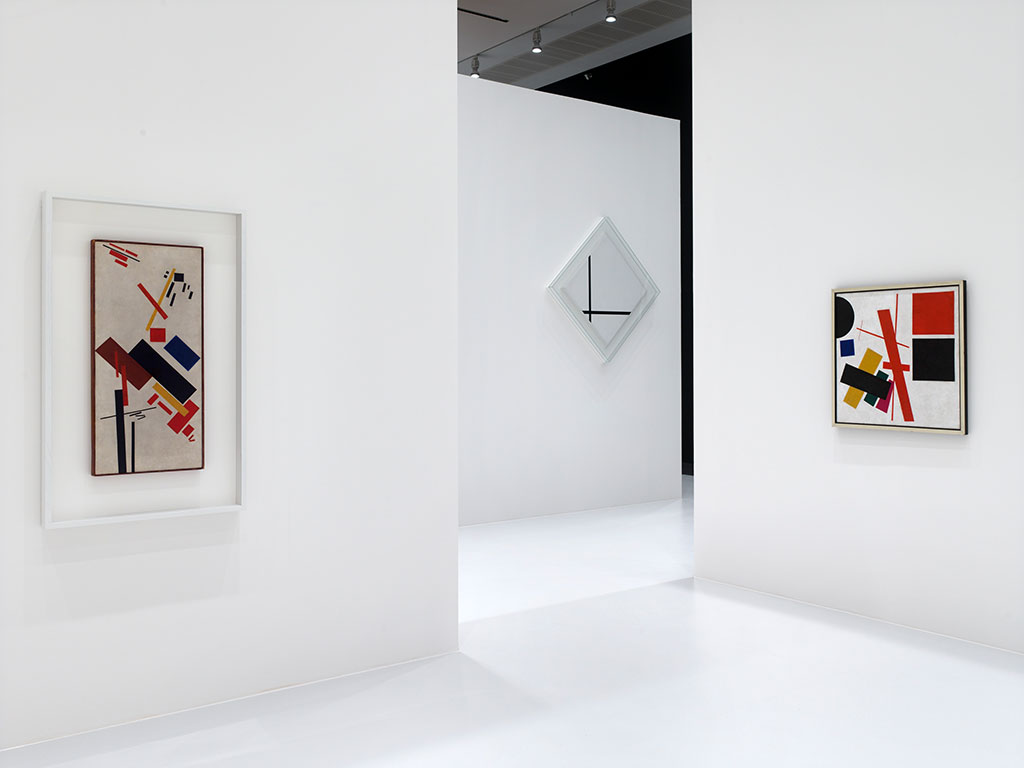Kandinsky, Malewitsch, Mondrian – Der weiße Abgrund Unendlichkeit
Apr 4, 2014 — Jul 6, 2014 (Quadrinale Düsseldorf)
With the exhibition Kandinsky, Malevich, Mondrian – The Infinite White Abyss the Kunstsammlung Nordrhein-Westfalen takes up the multifaceted theme of the white surface in the works of three major modernist masters. For these avant-garde pioneers, white was not merely an element of their color palettes: it was a symbol representing the world of the future. “The white, empty abyss, infinity lies before us” proclaimed Kazimir Malevich in 1919, coining a metaphor that was seminal for his art.
The white field, representing emptiness, nothingness, is the monochrome ground against which his geometric forms seem to float weightlessly. At the same time, white for Malevich was a mystical hue, one he characterized as a pure stimulus. White in this sense is mentioned in numerousSuprematist writings. "In the vast space of cosmic celebration, I create the white world of suprematist non-objectivity as a manifestation of liberated nothingness" states Malevich in the programmatic text entitled "Non-Objective Creation and Suprematism", published in 1922. In his search for a new existential basis for humanity, he saw the supremacy of white as embodying the highest fulfilment of non-objectivity and associated it with idealist thought to frame radical conceptions of a future society.
For Wassily Kandinsky too, the white surface represented a space of possibilities. White is "a silence that is not dead, but full of possibilities" we read in his text on color symbolism On the Spiritual in Art (1911): white is now seen as a potential originary force, as "the positive, the creative". For Kandinsky, the "white, fertilizing ray leads to evolution, elevation" ("On the Problem of Form", in Der Blaue Reiter, 1912). Piet Mondrian took up Theo van Doesburg’s juxtaposition of black, gray, and white as negative colors against the positive primaries red, yellow, and blue. As negation, and linked with the property of absence, the non-color white was accorded a special weight in his paintings.
Initially, the white surface was deployed as a continuum; later it would be delimited by black lines. Through the interplay between the pacification and activation of the picture ground, its impact on the viewer is immediate. The early twentieth century saw pioneering discoveries in modern physics, including relativity theory and quantum physics. In light of Einstein’s theory of relativity, and with reference to the paintings of Malevich and Kandinsky, we can say that space is engendered only by forms in motion within gravitation, or through their disintegration into weightlessness; the principle of cause and effect, as well as the directionality and velocity of movement, suggest the existence of four-dimensional space-time. In different ways, these three artists were preoccupied with the discoveries of the natural sciences in developing their specific worldviews.
By linking Theosophical ideas with modern physics, they called traditional notions of space and time into question, searching for paths into further dimensions within the picture space. Like Kandinsky, Malevich considered matter to be the agglomeration of energetic, rhythmic vibrations, which he in turn identified with emotional ambience. Through experimental and analytical procedures, Mondrian sought to arrive at new pictorial solutions. His works, which explore the unlimited possibilities of configuring pictorial elements, are based on the system of Neoplasticism, which determines the basic laws governing such relationships. At the dawn of the twentieth century, a yearning for the future shaped the self-understanding of the contemporary artistic avant-gardes, at the same time summoning forth new modes of artistic production.
Established in Russia during the 1910s–1920s, for example, was a series of institutions where artistic processes and scientific methods were linked. In the "laboratory", with its origins in natural-scientific discovery, these artists devised new forms of artistic creativity. In the context of their perpetual interrogation of the basic properties of colors and forms, a central significance was attributed to the color white.

